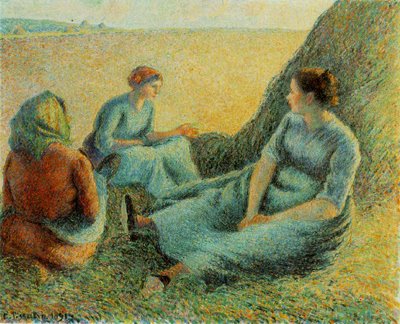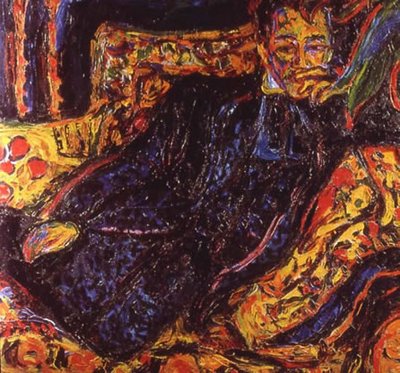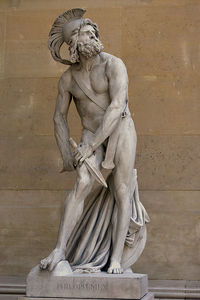A guard told me that despite Ms. McNay's death, she has not been absent from the parts of the museum that formed her house. There have been numerous sightings of her ghost dressed in period 1920s garb moving about the domicile. The most amusing related to McNay's loathing of Georgia O'Keefe. In the mid-90s, there was an exhibit of O'Keefe's works in the wing of the museum beyond the original house. The museum store, however, is part of the old house. One morning, the staff entered the building to find all O'Keefe-related items in the store trashed and shredded, but everything else left alone.
I took a few pages of notes and thought that I would share a few images from the McNay's collection.
 This is Haymakers Resting (1891) by Camille Pissarro. It is an idealized portrait of rural life. Pissarro was influenced by Neo-Impressionist Seurat's pointillism, which created a shimmering effect across the canvas.
This is Haymakers Resting (1891) by Camille Pissarro. It is an idealized portrait of rural life. Pissarro was influenced by Neo-Impressionist Seurat's pointillism, which created a shimmering effect across the canvas. This is Portrait of Hans Frisch (1907) by Ernst Ludwig Kirchner. Kirchner was a German Expressionist who conveyed the anxiety of urban life before World War I. He made this painting by squeezing paint from tubes directly onto the canvas and then shaping it with a palette knife.
This is Portrait of Hans Frisch (1907) by Ernst Ludwig Kirchner. Kirchner was a German Expressionist who conveyed the anxiety of urban life before World War I. He made this painting by squeezing paint from tubes directly onto the canvas and then shaping it with a palette knife. This is War Mother by Charles Umlauf. Umlauf (1911-1994) was a native of Michigan who studied at the Art Institute of Chicago and later taught at the University of Texas. He was an Expressionistic figure sculptor. War Mother, created on the eve of World War II, is an attempt to depict the ghastly suffering of innocent people during war.
This is War Mother by Charles Umlauf. Umlauf (1911-1994) was a native of Michigan who studied at the Art Institute of Chicago and later taught at the University of Texas. He was an Expressionistic figure sculptor. War Mother, created on the eve of World War II, is an attempt to depict the ghastly suffering of innocent people during war. The McNay also had a gilded bronze cast of Philopoemen (1837) by Pierre-Jean David d'Angers. This was one of the handful of Academic pieces in the collection. Philopoemen was a 3rd and 2nd Century B.C. Achaean general who ably defended the Achaean League against vastly larger Spartan, Macedonian, and Roman threats. He was a brutally self-disciplined soldier who eschewed vanity and luxury. Plutarch called him "the last of the Greeks":
The McNay also had a gilded bronze cast of Philopoemen (1837) by Pierre-Jean David d'Angers. This was one of the handful of Academic pieces in the collection. Philopoemen was a 3rd and 2nd Century B.C. Achaean general who ably defended the Achaean League against vastly larger Spartan, Macedonian, and Roman threats. He was a brutally self-disciplined soldier who eschewed vanity and luxury. Plutarch called him "the last of the Greeks":Philopoemen wore humble clothes and behaved like a plain man. Once, after he had become general of the Achaeans, a hostess at Megara received word that Philopoemen would be coming to dinner, and she began preparing a suitably grand reception. While the household was in an uproar with these preparations, Philopoemen arrived early. He was dressed in his usual humble clothes, so the hostess thought he was a servant sent ahead by her husband, and she ordered him to chop wood. Without a word, Philopoemen obeyed. The host arrived, and was surprised to find the guest of honor hard at work. "I am paying the penalty for my ugly looks," said Philopoemen.

3 comments:
I grew up near the McNay Museum and spent many happy hours browsing there. I haven't been back in several years. I'm glad you and your wife visited. It's a rare gem.
It's set in a beautiful neighborhood where my wife lived for two years after she graduated college. I like the place. Especially the McNay's lovely rock garden in the front.
It is a beautiful museum and the university across the street isn't half bad either.
PAX
JD
Post a Comment